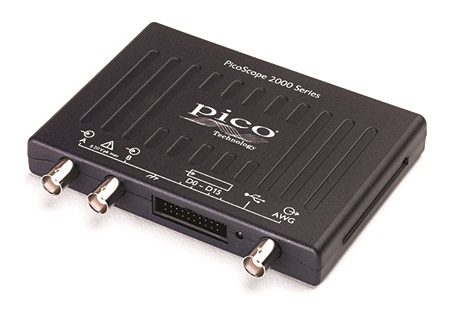 Wilt
u analoge en digitale signalen tegelijkertijd meter dan is
de 22xxMSO serie de scope-serie voor u. Wilt
u analoge en digitale signalen tegelijkertijd meter dan is
de 22xxMSO serie de scope-serie voor u.
•2 analogue
channels
•16 digital channels
•Measure analogue
signals up to 100 MHz
•Measure digital signals up to 100
MHz
•1 GS/s mixed–signal sampling
•Built–in function
generator and arbitrary waveform generator
•USB–powered
With the PicoScope 22xx mixed–Signal Oscilloscope (MSO)
it is possible for you to measure both analogue and digital
signals at the same time, using one device, and view the
analogue waveforms and digital data on the same screen.
The ultimate test and measurement laboratory
Your PicoScope 22xx MSO is more than a just another
instrument — it’s the ultimate test and measurement
laboratory. You can use your PicoScope 22xx MSO as a dual–channel oscilloscope, a logic analyzer, a spectrum
analyzer, a function generator and an arbitrary waveform
generator. Five professional–quality instruments in one
compact, low–cost, USB–powered unit.
Use
it as an oscilloscope
With up to 100 MHz analogue
bandwidth, 1GS/s real–time sampling and a 128MS kilosample
buffer your PicoScope 22xx MSO is a powerful 8–bit,
two–channel USB oscilloscope that is suitable for circuit
design, testing and troubleshooting.
This
full–featured oscilloscope offers mask limit testing, maths
and reference channels, advanced digital triggering, serial
decoding, automatic measurements and color persistence
display.
Use it as a logic analyzer
The 16 digital inputs of your PicoScope 22xx MSO can be
displayed individually or in arbitrary groups labeled with
binary, decimal or hexadecimal values. A separate logic
threshold from -5 V to +5 V can be defined for each 8–bit
input port. The digital trigger can be activated by any bit
pattern combined with an optional transition on any input.
Advanced logic triggers can be set on either the analogue or
digital input channels, or both to enable complex
mixed–signal triggering.
U kunt de Pico 22xx
MSO gebruiken als...
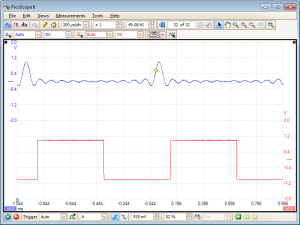
...een osciloscoop |
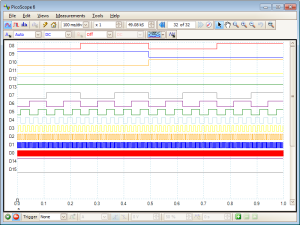
...een logic analyser |
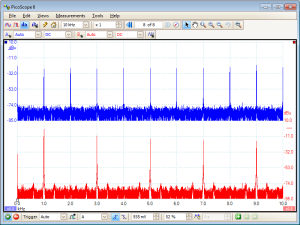
... een spectrum analyser |
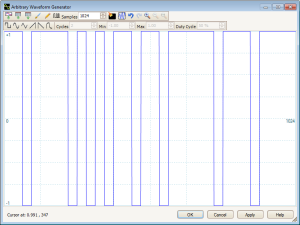
...een functiegenerator met AWG
|
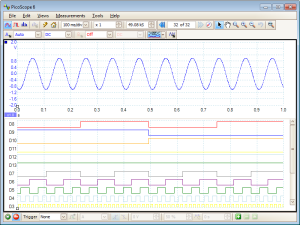
...een mixed-signal scope |
|
|
Why pay more?
At Pico we don’t do
“optional extras”. Other companies may think that you should
pay for high–end features such as mask limit testing, serial
decoding, advanced triggering, automatic measurements, math
channels, XY mode, digital filtering and segmented memory.
We don’t. When you buy a PicoScope USB mixed–Signal
Oscilloscope everything is included in the price.
For today, tomorrow and the future
With many companies once you’ve purchased your product
that’s the end of your relationship. When you purchase your
PicoScope that’s only the beginning of your relationship
with us. We want to make sure your PicoScope continues to
meet your needs for a long time to come. To do this we
regularly update our software with new features and
improvements — many suggested by you, our customers, and all
designed to let you get more from your scope. At the same
time we’ve made sure our PicoScope software can be used with
all of our standard PC oscilloscopes so if you ever want to
upgrade you don’t need to learn a new software package.
Many of our customers become lifelong PicoScope users.
We hope you’ll be one of them.
The
mixed–signal oscilloscope that you need
The
ability to measure two analogue signals of up to 100 MHz together with 16 digital signals of up to 100 MHz, combined
with a 1GS/s sampling rate and 128MS buffer memory makes
the PicoScope 22xx MSO a powerful mixed–signal oscilloscope.
The compact, USB–powered design means that this is one
mixed–signal oscilloscope that can be used both on your
desktop or in the field. While the ability to also use it as
spectrum analyzer, function generator and arbitrary waveform
generator gives you a complete test and measurement lab at a
price you can afford.
If you want to measure both
analogue and digital signals then the PicoScope 22xx MSO is
the mixed–signal oscilloscope that you need.
|
PicoScope 2000 Specifications |
|
Model
|
PicoScope |
|
Bandwidth |
10 MHz |
25 MHz |
50 MHz |
70 MHz |
100 MHz |
|
2 channel |
2204A |
2205A |
|
2206B |
|
2207B |
2208B |
|
4 channel |
|
|
2405A |
|
2406B |
2407B |
2408B |
|
2 channel MSO |
|
|
2205A MSO |
|
2206B MSO |
2207B MSO |
2208B MSO |
|
Oscilloscope — vertical (analog
inputs) |
|
Bandwidth |
10 MHz |
25 MHz |
50 MHz |
70 MHz |
100 MHz |
|
Rise time (calculated) |
35 ns |
14 ns |
7 ns |
5 ns |
3.5 ns |
|
Vertical resolution |
8 bits |
|
Enhanced vertical resolution |
Up to 12 bits |
|
Input ranges |
±50 mV, ±100 mV, ±200 mV, ±500 mV, ±1 V, ±2
V, ±5 V, ±10 V, ±20 V |
±20 mV, ±50 mV, ±100 mV, ±200 mV, ±500 mV,
±1 V, ±2 V, ±5 V, ±10 V, ±20 V |
|
Input sensitivity |
10 mV/div to 4 V/div |
4 mV/div to 4 V/div |
|
(10 vertical divisions) |
|
Input coupling |
AC / DC |
|
Input connector |
BNC(f) |
|
Input characteristics |
1 MΩ ± 1% ∥ 14 pF ± 2 pF |
1 MΩ ± 1% ∥ 16 pF ± 1 pF |
|
Analog offset range |
None |
±250 mV (20 mV to 200 mV ranges) |
|
(vertical position adjustment) |
±2.5 V (500 mV to 2 V ranges) |
|
|
±25 V (5 V to 20 V ranges) |
|
Analog offset control accuracy |
N/A |
±1% of offset setting, additional to basic
DC accuracy |
|
DC accuracy |
±3% of full scale ±200 μV |
|
Overvoltage protection |
±100 V (DC + AC peak) |
|
Oscilloscope — vertical (digital
inputs, MSOs only) |
|
Input channels |
16 channels (2 ports of 8 channels each) |
|
Input connectors |
2.54 mm pitch, 10 x 2 way connector |
|
Maximum input frequency |
100 MHz (200 Mb/s) |
|
Minimum detectable pulse width |
5 ns |
|
Input impedance |
200 kΩ ±2% ∥ 8 pF ±2 pF |
|
Input dynamic range |
±20 V |
|
Digital threshold range |
±5 V |
|
Overvoltage protection |
±50 V |
|
Threshold grouping |
Two independent threshold controls: Port 0:
D0 to D7, Port 1: D8 to D15 |
|
Threshold selection |
TTL, CMOS, ECL, PECL, user-defined |
|
Port threshold accuracy |
±350 mV (inclusive of hysteresis) |
|
Hysteresis |
< ±250 mV |
|
Minimum input voltage swing |
500 mV pk-pk |
|
Channel-to-channel skew |
2 ns typical |
|
Minimum input slew rate |
10 V/µs |
|
Horizontal |
|
Maximum sampling rate (real-time)* |
100 MS/s |
200 MS/s |
500 MS/s |
1 GS/s |
|
Equivalent sampling rate (ETS mode) |
2 GS/s |
4 GS/s |
5 GS/s |
10 GS/s |
|
Maximum sampling rate (USB streaming) |
1 MS/s |
1 MS/s |
9.6 MS/s |
|
Shortest timebase |
10 ns/div |
5 ns/div |
2 ns/div |
1 ns/div |
|
Longest timebase |
5000 s/div (approx 14 hours per waveform in
chart recorder view) |
|
Buffer memory (block mode)* |
8 kS |
16 kS |
48 kS |
32 MS |
64 MS |
128 MS |
|
Buffer memory (USB streaming mode) |
100 MS (shared between active channels) |
|
Waveform buffers |
10 000 |
|
Maximum waveforms per second |
2000 |
80 000 |
|
Initial timebase accuracy |
±100 ppm |
±50 ppm |
|
Timebase drift |
±5 ppm / year |
|
Sample jitter |
30 ps RMS typical |
3 ps RMS typical |
|
ADC sampling |
Simultaneous |
Simultaneous |
* Maximum sampling rate and buffer memory
are shared between active channels. On MSO
models each
group of 8 inputs
counts as a channel. Maximum sampling rate
on MSO digital channels is 500 MS/s. |
|
Dynamic performance |
|
Crosstalk (full bandwidth, equal ranges) |
Better than 200:1 |
Better than 300:1 |
|
Harmonic distortion |
< –50 dB at 100 kHz, full-scale input,
typical |
|
SFDR (100 kHz, full-scale input, typical) |
> 52 dB |
±20 mV range: > 44 dB |
|
±50 mV range and higher: > 52 dB |
|
Noise |
< 150 μV RMS |
< 220 μV RMS |
< 300 μV RMS |
|
(±50 mV range) |
(±20 mV range) |
(±20 mV range) |
|
Bandwidth flatness |
(+0.3 dB, –3 dB) from DC to full bandwidth |
|
Triggering |
|
Sources |
Ch A, Ch B, Ch C, Ch D. Any MSO digital
channel |
|
Trigger modes |
None, auto, repeat, single |
None, auto, repeat, single, rapid (segmented
memory) |
|
Advanced triggers |
Edge, window, pulse width, window pulse |
Edge, window, pulse width, window pulse
width, dropout, |
|
width, dropout, window dropout, interval, |
window dropout, interval, runt pulse, logic |
|
logic |
|
|
Trigger types, ETS |
Rising or falling edge |
Rising or falling edge (available on Ch A
only) |
|
Trigger sensitivity, real-time |
Digital triggering provides 1 LSB accuracy
up to full bandwidth |
|
Trigger sensitivity, ETS |
10 mV p-p, typical, at full bandwidth |
|
Maximum pre-trigger capture |
100% of capture size |
|
Maximum post-trigger delay |
4 billion samples |
|
Trigger rearm time in rapid trigger mode |
N/A |
< 2 μs on fastest |
< 1 μs on fastest timebase |
|
timebase |
|
Max. waveforms in rapid trigger mode |
N/A |
96 |
10 000 |
|
Function
generator |
|
Standard output signals |
Sine, square, triangle, DC voltage, ramp,
sinc, Gaussian, half-sine |
|
Pseudorandom output signals |
None |
White noise, PRBS |
|
Standard signal frequency |
DC to 100 kHz |
DC to 1 MHz |
|
Sweep modes |
Up, down, dual with selectable start/stop
frequencies and increments |
|
Triggering |
None |
Free-run or up to 1 billion waveform cycles
or frequency sweeps. |
|
Triggered from scope trigger or manually. |
|
Output frequency accuracy |
Oscilloscope timebase accuracy ± output
frequency resolution |
|
Output frequency resolution |
< 0.02 Hz |
< 0.01 Hz |
|
Output voltage range |
±2 V |
|
Output adjustments |
Any amplitude and offset within ±2 V range |
|
Amplitude flatness (typical) |
< 1 dB to 100 kHz |
< 0.5 dB to 1 MHz |
|
DC accuracy |
±1% of full scale |
|
SFDR (typical) |
> 55 dB at 1 kHz full-scale sine wave |
> 60 dB at 10 kHz full-scale sine wave |
|
Output characteristics |
Front panel BNC, 600 Ω output impedance |
|
Overvoltage protection |
±20 V |
|
Arbitrary
waveform generator |
|
Update rate |
1.548 MHz |
20 MHz |
|
Buffer size |
4 kS |
8 kS |
32 kS |
|
Resolution |
12 bits |
|
Bandwidth |
> 100 kHz |
> 1 MHz |
|
Rise time (10% to 90%) |
< 2 μs |
< 120 ns |
|
Spectrum
analyzer |
|
Frequency range |
DC to analog bandwidth of oscilloscope |
|
Display modes |
Magnitude, average, peak hold |
|
Windowing functions |
Rectangular, Gaussian, triangular, Blackman,
Blackman-Harris, Hamming, Hann, flat-top |
|
Number of FFT points |
Selectable from 128 to half available buffer
memory in powers of 2, up to a maximum of 1
048 576 points |
|
Math
channels
and Software filters |
|
Functions |
−x, x+y, x−y, x*y, x/y, x^y, sqrt, exp, ln,
log, abs, norm, sign, sin, cos, tan, arcsin,
arccos, arctan, sinh, cosh, tanh, freq,
derivative, integral, min, max, average,
peak, delay, duty |
|
Software filters |
Highpass, lowpass, bandpass, bandstop |
|
Operands |
A, B (input channels), C, D (input channels,
4-channel models only), T (time), reference
waveforms, constants, pi, digital channels
(MSO models only) |
|
Automatic
measurements |
|
Scope mode |
AC RMS, true RMS, frequency, cycle time,
duty cycle, DC average, falling rate, rising
rate, low pulse width, high pulse width,
fall time, rise time, minimum, maximum, peak
to peak |
|
Spectrum mode |
Frequency at peak, amplitude at peak, THD
dB, SNR, SINAD, SFDR, |
|
total power, average amplitude at peak, THD
%, THD+N, IMD |
|
Statistics |
Minimum, maximum, average and standard
deviation |
|
Serial
decoding |
|
Protocols |
1-Wire, ARINC 429, CAN, DCC, DMX512, FlexRay,
Ethernet 10Base-T, USB 1.1, I²C, I²S, LIN,
PS/2, SPI, SENT, UART/RS-232 (subject to
bandwidth and sampling rate of chosen
oscilloscope model) |
|
Mask
limit testing |
|
Mask generation |
Numeric (automatic) or Graphical (manual) |
|
Statistics |
Pass/fail, failure count, total count |
|
Available actions on mask fail |
Beep, play sound, stop capture, save
waveform, trigger signal generator / AWG,
run executable |
|
Display |
|
Interpolation |
Linear or sin(x)/x |
|
Persistence modes |
Digital color, analog intensity, custom,
fast or none |
|
SDK / API details and specifications for
customers writing their own software |
|
Supplied drivers |
32 and 64-bit drivers for Windows 7, 8 and
10 |
|
Linux drivers |
|
Mac OS X drivers |
|
Example code |
C, C#, Excel VBA, VB.NET, LabVIEW, MATLAB |
|
Maximum USB streaming sampling rate* |
1 MS/s |
5 MS/s |
31 MS/s |
|
Buffer memory in USB streaming mode* |
Limited only by PC |
|
Segmented memory buffers* |
N/A |
96 |
128000 |
256000 |
512000 |
* These specifications apply when using the
drivers / writing your own software.
Refer to Horizontal section above when using
PicoScope software |
|
General |
|
Package contents |
PicoScope 2000 series oscilloscope |
|
2 or 4 switchable 10:1/1:1 oscilloscope
probes (except for PicoScope 2204A / 2205A
when purchased without probes) |
|
TA136 digital cable (MSOs only) |
|
2 × TA139 pack of 10 logic test clips (MSOs
only) |
|
USB cable |
|
Software and reference CD |
|
Quick start guide |
|
PC connectivity |
USB 2.0 (USB 3.0/3.1 compatible). |
|
Power requirements |
Powered from USB port |
|
Dimensions |
142 x 92 x 18.8 mm |
130 x 104 x 18.8 mm |
|
(including connectors and feet) |
|
Weight |
< 0.2 kg (7 oz) |
|
Temperature range, operating |
0 °C to 50 °C |
|
Temperature range, operating, for |
15 °C to 30 °C |
|
stated accuracy |
|
Temperature range, storage |
–20 °C to +60 °C |
|
Humidity range, operating |
5% to 80% RH non-condensing |
|
Humidity range, storage |
5% to 95% RH non-condensing |
|
Altitude range |
up to 2000 m |
|
Pollution degree |
2 |
|
Safety approvals |
Designed to EN 61010-1:2010 |
|
Environmental approvals |
RoHS, WEEE |
|
EMC approvals |
Tested to meet EN61326-1:2013 and FCC Part
15 Subpart B |
|
Software included |
PicoScope 6 for Microsoft Windows 7, 8 and
10 |
|
32-bit and 64-bit SDK for Windows 7, 8 and
10 |
|
32-bit and 64-bit example programs (C,
Microsoft Excel VBA, LabVIEW) |
|
Free software available for download |
PicoScope 6 (beta) for
Linux and
OS X.
Please note that the Linux and OS X beta
versions of PicoScope do not yet have mask
limit test or math channel functions. |
|
SDK (beta) for
Linux
and
OS X |
|
Languages supported |
Simplified Chinese, Czech, Danish, Dutch,
English, Finnish, French, German, Greek,
Hungarian, Italian, Japanese, Korean,
Norwegian, Polish, Portuguese, Romanian,
Russian, Spanish, Swedish, Turkish |
|
|
 Wilt
u analoge en digitale signalen tegelijkertijd meter dan is
de 22xxMSO serie de scope-serie voor u.
Wilt
u analoge en digitale signalen tegelijkertijd meter dan is
de 22xxMSO serie de scope-serie voor u.




